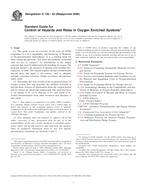Potřebujeme váš souhlas k využití jednotlivých dat, aby se vám mimo jiné mohly ukazovat informace týkající se vašich zájmů. Souhlas udělíte kliknutím na tlačítko „OK“.
ASTM G128-02(2008)
Standard Guide for Control of Hazards and Risks in Oxygen Enriched Systems
Automaticky přeložený název:
Standardní Příručka pro kontrolu rizik a rizik v obohacené kyslíkem systémy
NORMA vydána dne 1.9.2008
Informace o normě:
Označení normy: ASTM G128-02(2008)
Poznámka: NEPLATNÁ
Datum vydání normy: 1.9.2008
Kód zboží: NS-57331
Počet stran: 15
Přibližná hmotnost: 45 g (0.10 liber)
Země: Americká technická norma
Kategorie: Technické normy ASTM
Anotace textu normy ASTM G128-02(2008) :
Keywords:
adiabatic compression, autoignition, barriers, cleaning, combustion, compression heating, contamination, explosion, fire, flammability, GOX, ignition, liquid oxygen, LOX, material evaluation, material selection, oxygen , oxygen compatibility, oxygen enriched, oxygen hazard, oxygen safety, oxygen service, oxygen systems, shielding, Adiabatic compression, Autoignition conditions/temperature, Cleaning agents/processes, Combustion, Compression heating
Doplňující informace
| Significance and Use | ||||||||||||||||
|
The purpose of this guide is to introduce the hazards and risks involved with the handling of oxygen, cautioning the reader about the limitations of present practices and technology and about common hazards that often are overlooked. It then provides an overview of the standards produced by ASTM Committee G-4 and their uses, as well as similar documents available from other knowledgeable sources. It does not highlight standard test methods that support the use of these practices from this or other committees. The standards discussed here focus on reducing the hazards and risks associated with the use of oxygen. In general, they are not directly applicable to process reactors in which the deliberate reaction of materials with oxygen is sought, as in burners, bleachers, or bubblers. Other ASTM Committees and products (such as the CHETAH program ) and other outside groups are more pertinent for these. This guide is not intended as a specification to establish practices for the safe use of oxygen. The documents discussed here do not purport to contain all the information needed to design and operate an oxygen system safely. The control of oxygen hazards has not been reduced to handbook procedures, and the tactics for using oxygen are not unique. Rather, they require the application of sound technical judgement and experience. Oxygen users should obtain qualified technical expertise to design systems and operating practices to ensure the safe use of oxygen in their specific applications. |
||||||||||||||||
| 1. Scope | ||||||||||||||||
|
1.1 This guide covers an overview of the work of ASTM Committee G-4 on Compatibility and Sensitivity of Materials in Oxygen-Enriched Atmospheres. It is a starting point for those asking the question: “Are there any problems associated with my use of oxygen?” An introduction to the unique concerns that must be addressed in the handling of oxygen. The principal hazard is the prospect of ignition with resultant fire, explosion, or both. This hazard requires design considerations beyond those that apply to all systems, such as adequate strength, corrosion resistance, fatigue resistance, and pressure safety relief. 1.2 This guide also lists several of the recognized causes of oxygen system fires and describes the methods available to prevent them. Sources of information about the oxygen hazard and its control are listed and summarized. The principal focus is on Guides G 63, G 88, Practice G 93, and Guide G 94. Useful documentation from other resources and literature is also cited. Note 1—This guide is an outgrowth of an earlier (1988) Committee G-4 videotape adjunct entitled Oxygen Safety and a related paper by Koch that focused on the recognized ignition source of adiabatic compression as one of the more significant but often overlooked causes of oxygen fires. This guide recapitulates and updates material in the videotape and paper. 1.3 This standard
does not purport to address all of the safety concerns, if any,
associated with its use. It is the responsibility of the user of
this standard to establish appropriate safety and health practices
and determine the applicability of regulatory limitations prior to
use. For specific precautionary statements see
Sections 8 and 11. Note 2—ASTM takes no position respecting the validity of any evaluation methods asserted in connection with any item mentioned in this guide. Users of this guide are expressly advised that determination of the validity of any such evaluation methods and data and the risk of use of such evaluation methods and data are entirely their own responsibility. |
||||||||||||||||
| 2. Referenced Documents | ||||||||||||||||
|
Doporučujeme:
EviZak - všechny zákony včetně jejich evidence na jednom místě
Poskytování aktuálních informací o legislativních předpisech vyhlášených ve Sbírce zákonů od roku 1945.
Aktualizace 2x v měsíci !
Chcete vědět více informací? Podívejte se na tuto stránku.




 Cookies
Cookies
